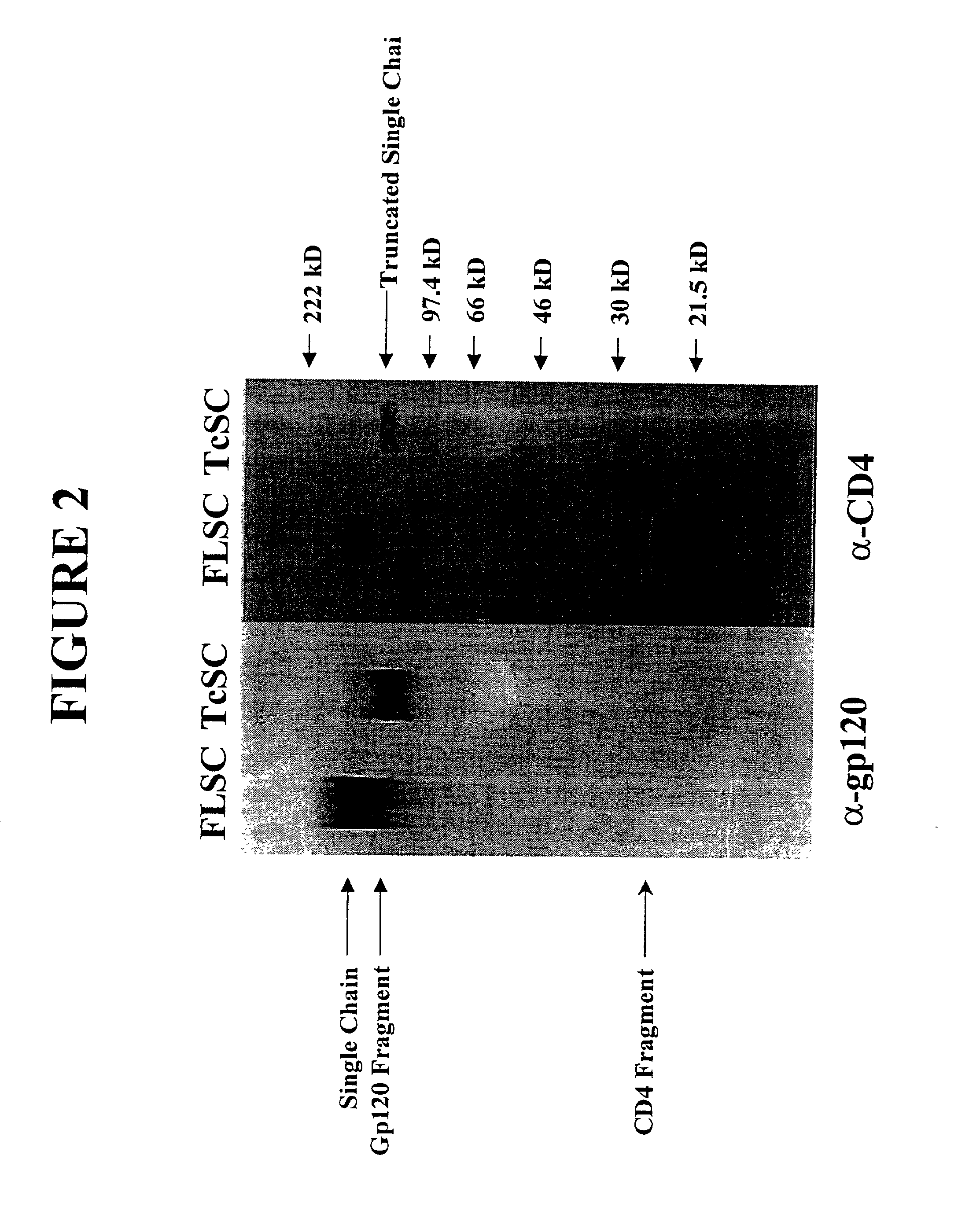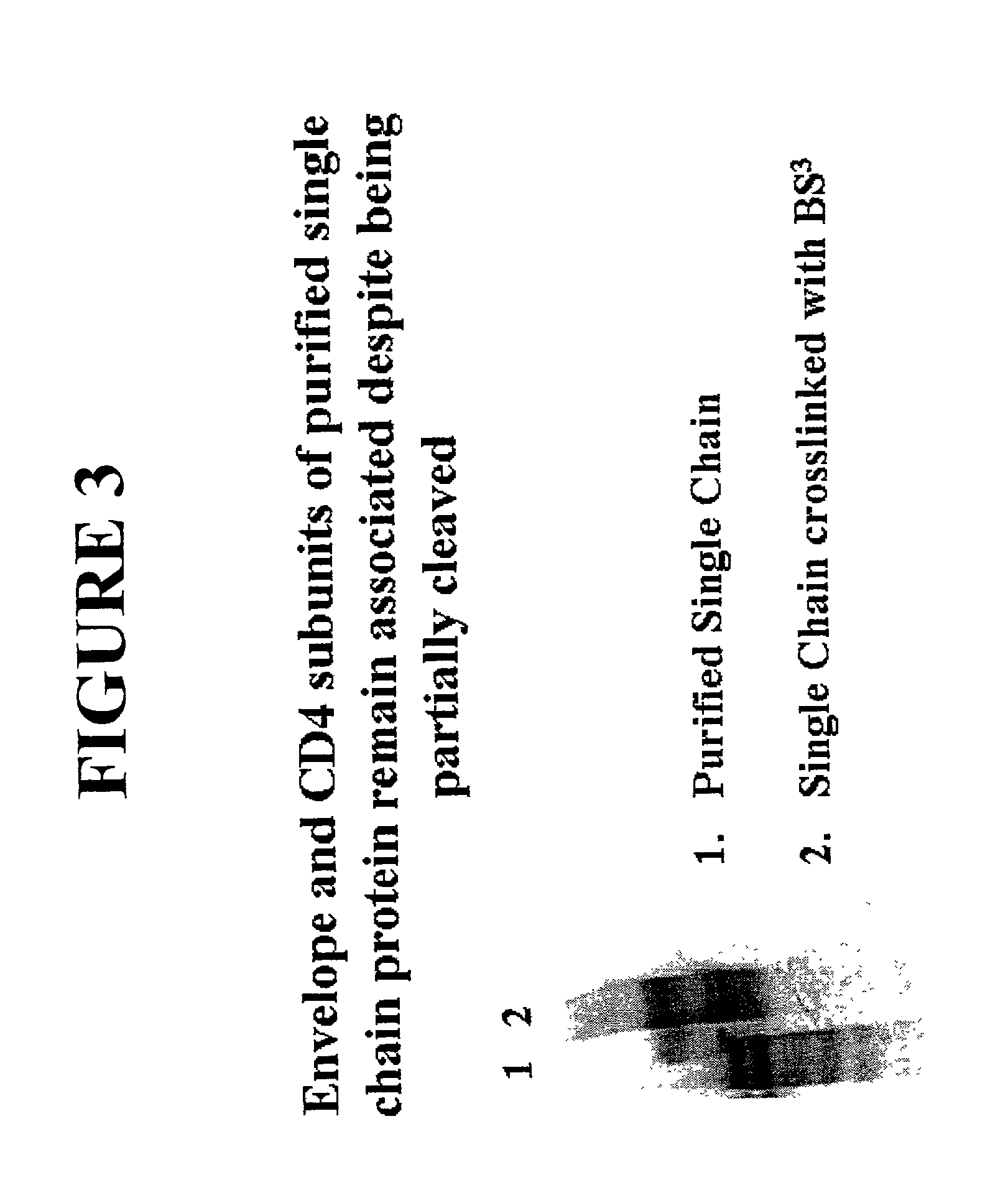Virus coat protein/receptor chimeras and methods of use
a virus and chimeric polypeptide technology, applied in the field of receptor ligand interaction, can solve the problems of reducing the risk of virus infection, reducing the risk of infection, and reducing the effect of chimeric polypeptide binding affinity
- Summary
- Abstract
- Description
- Claims
- Application Information
AI Technical Summary
Benefits of technology
Problems solved by technology
Method used
Image
Examples
example ii
[0147] This Example describes the transfection of cells with the polynucleotide encoding the gp 120-CD4 chimeric polypeptide and the characterization of the expressed soluble polypeptide. Recombinant pEF6-FLSC or pEF6-TcSC was transfected into 293 cells using Fugene, according to the manufacturer's protocol (Boehringer-Manheim). Stable transfectants were obtained by selection with 5 .mu.g / ml blasticidin. A stable cell line (293-SC) was cultured under different conditions, and the production of chimeric polypeptide evaluated by immunoblot analysis using a mixture of anti-gp120 monoclonal antibodies (Y. H. Abacioglu et al.,AIDS Res. Hum. Retroviruses, 10:371-81 (1994)) or anti-human CD4 polyclonal sera (T4-4) (K. C. Deen et al., Nature, 331:82-4 (1998); R. L. Willey et al., J Viral., 66:226-34 (1992); NIH AIDS Reagent Repository).
[0148] Briefly, cell culture supernatants containing the chimeric polypeptide were collected and boiled in SDS-PAGE loading buffer (75 mM Tris, 2% SDS, 10% g...
example iii
[0153] This Example describes data demonstrating the binding of gp120-CD4 chimeric polypeptide to several different antibodies reactive with gp120 and CD4. The binding of gp120 to CD4 causes conformational changes in the molecule leading to the exposure of the co-receptor-binding domain. Therefore, antibodies directed against epitopes in this domain should react strongly with properly folded single-chain molecules. In order to determine exposed epitopes in chimeric molecules, antigenic properties of FLSC and TcSC molecules were compared. Purified FLSC and TcSC were subjected to immunochemical analyses by antigen capture ELISA. In brief, BaLgp120, gp120-rsCD4 complexes or single chain chimeric molecules were captured using a purified polyclonal sheep antibody (International Enzymes, Fallbrook, Calif.) raised against a peptide derived from the C-terminal 15 amino acids of gp120, D7324 (J. P. Moore et al., AIDS Res. Hum. Retroviruses, 4:369-79 (198X)), adsorbed to the matrix. The D7324...
example iv
[0160] This Example describes data demonstrating the binding of gp120-CD4 chimeric molecules, containing a CCR5-specific HIV envelope sequence, to CCR5 expressing cells.
[0161] The formation of the gp120-CD4 complex normally exposes the envelope domains that interact with an appropriate co-receptor (M. Thali et al., J Virol., 67:3978-86 (1993); M. A. Vodicka et al., Virol., 233:193-8 (1997)). Therefore, another measure of properly folded gp120-CD4 complexes and its ability to inhibit virus infection of a cell is the ability to bind to a CCR5 co-receptor.
[0162] To evaluate the ability of the single-chain complexes to bind co-receptor, purified single-chain gp120-CD4 molecules were allowed to interact with cells that express either CCR5 or CXCR4. Briefly, supernatants containing gp120-CD4 single-chain were generated by transient transfection of 293 cells with pEF6-SC. Supernatants were then added to an immunoaffinity column of A32 and the purified single-chain eluted with 0.2 M Acetic ...
PUM
| Property | Measurement | Unit |
|---|---|---|
| concentrations | aaaaa | aaaaa |
| temperature | aaaaa | aaaaa |
| temperature | aaaaa | aaaaa |
Abstract
Description
Claims
Application Information
 Login to View More
Login to View More - R&D
- Intellectual Property
- Life Sciences
- Materials
- Tech Scout
- Unparalleled Data Quality
- Higher Quality Content
- 60% Fewer Hallucinations
Browse by: Latest US Patents, China's latest patents, Technical Efficacy Thesaurus, Application Domain, Technology Topic, Popular Technical Reports.
© 2025 PatSnap. All rights reserved.Legal|Privacy policy|Modern Slavery Act Transparency Statement|Sitemap|About US| Contact US: help@patsnap.com



